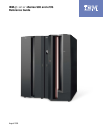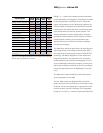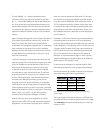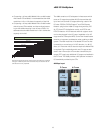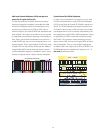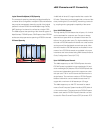5
z/Architecture
The zSeries is based on the z/Architecture
™
, which is
designed to reduce bottlenecks associated with the lack
of addressable memory and automatically directs resources
to priority work through Intelligent Resource Director. The
z/Architecture is a 64-bit superset of ESA/390.
z/Architecture is implemented on the z990 to allow full
64-bit real and virtual storage support. A maximum 256
GB of real storage is available on z990 servers. z990 can
defi ne any LPAR as having 31-bit or 64-bit addressability.
z/Architecture has:
• 64-bit general registers.
• New 64-bit integer instructions. Most ESA/390 architec-
ture instructions with 32-bit operands have new 64-bit
and 32- to 64-bit analogs.
• 64-bit addressing is supported for both operands
and instructions for both real addressing and virtual
addressing.
• 64-bit address generation. z/Architecture provides 64-bit
virtual addressing in an address space, and 64-bit real
addressing.
• 64-bit control registers. z/Architecture control registers
can specify regions, segments, or can force virtual
addresses to be treated as real addresses.
• The prefi x area is expanded from 4K to 8K bytes.
•
New instructions provide quad-word storage consistency.
• The 64-bit I/O architecture allows CCW indirect data
addressing to designate data addresses above 2 GB for
both format-0 and format-1 CCWs.
• IEEE Floating Point architecture adds twelve new instruc-
tions for 64-bit integer conversion.
• The 64-bit SIE architecture allows a z/Architecture server
to support both ESA/390 (31-bit) and z/Architecture
(64-bit) guests. Zone Relocation is expanded to 64-bit
for LPAR and z/VM
®
.
• 64-bit operands and general registers are used for all
Cryptographic instructions
• The implementation of 64-bit z/Architecture can help
reduce problems associated with lack of addressable
memory by making the addressing capability virtually
unlimited (16 Exabytes).
z/Architecture Operating System Support
The z/Architecture is a tri-modal architecture capable of
executing in 24-bit, 31-bit, or 64-bit addressing modes.
Operating systems and middleware products have been
modifi ed to exploit the new capabilities of the z/Architecture
.
Immediate benefi t can be realized by the elimination of the
overhead of Central Storage to Expanded Storage page
movement and the relief provided for those constrained by
the 2 GB real storage limit of ESA/390. Application programs
can run unmodifi ed on the zSeries family of servers.
Expanded Storage (ES) is still supported for operating sys-
tems running in ESA/390 mode (31-bit). For z/Architecture
mode (64-bit), ES is supported by z/VM. ES is not supported
by z/OS in z/Architecture mode.
Although z/OS does not support Expanded Storage when
running under the new architecture, all of the Hiperspace
™
and VIO APIs, as well as the Move Page (MVPG) instruc-
tion, continue to operate in a compatible manner. There is
no need to change products that use Hiperspaces.
Some of the exploiters of z/Architecture for z/OS include:
• DB2 Universal Database
™
Server for z/OS
• IMS
™
• Virtual Storage Access Method (VSAM)
• Remote Dual Copy (XRC)
• Tape and DASD access method



